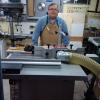I have a Rikon dust collector. I am considering modifying to size of the inlet to the fan from 5” to 6” . I would also run 6” ducts through out the shop. The problem I have is that the hose from the fan to the separator is only 5” and I cannot change this. So my question, is it worth while increasing the size of the inlet ducts when I can do nothing to the outlet side of the fan?




 Reply With Quote
Reply With Quote



